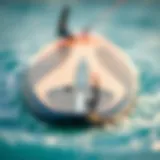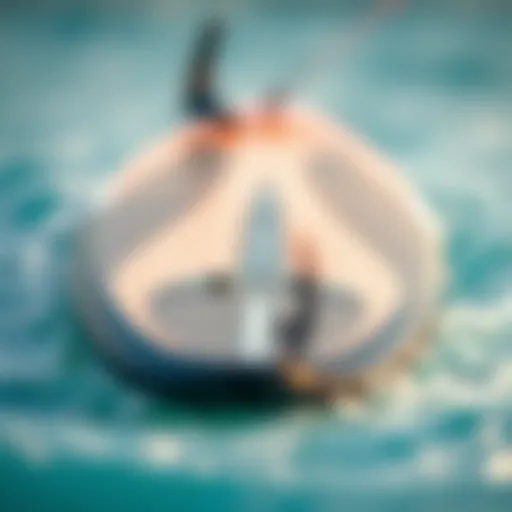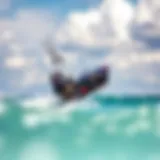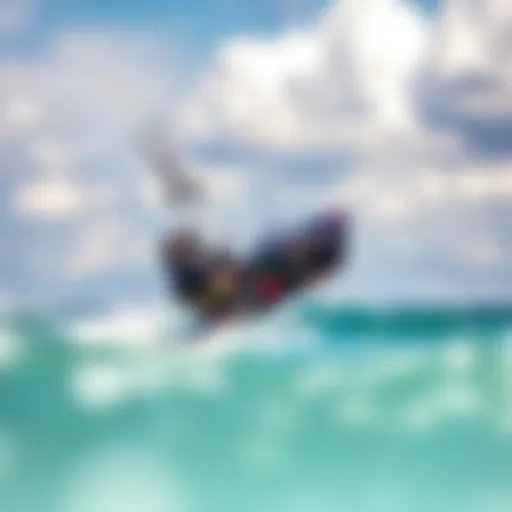Essential Gear for Beginner Kiteboarding: A Comprehensive Guide


Intro
Diving into the world of kiteboarding can feel like trying to read ancient hieroglyphics without a Rosetta Stone. As a beginner, it's crucial to decipher the essential gear that sets the stage for your adventures on the water. Choosing the right equipment isn't just about brand names or shiny features; it's about understanding how each piece functions and its impact on your performance and safety.
The variety of gear can be overwhelming. From kites that let the wind do the heavy lifting to boards designed for different conditions, knowing what to look for will help you make informed decisions. This guide is here to navigate you through the must-have essentials, breaking down the gear into digestible pieces. Prepare to gear up for an exhilarating journey as we unpack what you need to embark on this thrilling sport.
Understanding Kiteboarding Basics
Grasping the fundamentals of kiteboarding sets the stage for a successful journey in this exciting water sport. For beginners, the initial steps into kiteboarding can seem daunting, with a plethora of gear and techniques to consider. Understanding the basics is crucial; it not only enhances safety but also informs choices about gear that will suit your style and environment.
The more you know about the core components of kiteboarding, the better prepared you will be to navigate the nuances of the sport. This foundational knowledge helps prevent accidents and instills confidence as you progress, allowing you to enjoy the thrill of flying across the water.
What is Kiteboarding?
Kiteboarding, often referred to as kitesurfing, combines elements of surfing, windsurfing, and paragliding. A rider stands on a board while being pulled by a large, specially designed kite. The kite harnesses the power of the wind, giving the rider the freedom to carve through the water, jump, or even perform tricks. The harmony between wind and water creates an exhilarating experience unique to this sport.
The thrill lies in the ability to ride the waves, harnessing nature's forces for a dynamic experience. It's more than just a sport; it's an art form that invites creativity, as riders develop their own style.
The Evolution of Kiteboarding Gear
Kiteboarding gear has seen significant advancements since its inception in the 1990s. Initially, equipment was rudimentary, often cobbled together from various materials. Over the years, technological innovations have led to safer, more efficient designs that provide better performance and control.
Key developments in kiteboarding gear include:
- Kite Design: Modern kites are engineered for stability and responsiveness. The introduction of inflatable and foil kites caters to different riding styles and conditions.
- Control Systems: The evolution of bars and lines enhances maneuverability, allowing riders to feel more in control of their kite’s power and direction.
- Boards: Options like twintip and directional boards cater to various skills and preferences, providing different experiences on the water.
As kiteboarding continues to grow, so does the focus on safety and accessibility. Understanding this gear evolution helps beginners appreciate the tools available to them and encourages a thoughtful approach to gear selection.
"Knowing the ins and outs of equipment not only improves your performance but also enriches your overall kiteboarding experience."
In essence, understanding kiteboarding basics is about more than just the sport itself; it’s about embracing a lifestyle that involves wind, water, and community. Charting your course in this exciting world requires a solid grounding in its foundational elements.
Core Components of Kiteboarding Gear
Kiteboarding is not just about gliding over the waves; it’s a delicate dance with the elements, where your gear plays a pivotal role. Understanding the core components of kiteboarding gear is essential for beginners to enjoy the sport and progress safely. Each piece of equipment contributes to your overall performance and comfort, making the right selection crucial. The right gear not only enhances your skills but offers protections against the unexpected whims of nature.
Kite Types: An Overview
When it comes to kiteboarding, the kite is the heart of the operation. Let's break down the main types of kites you'll encounter:
Inflatable Kites
Inflatable kites are the most common choice among beginners. They are designed with inflatable bladders that provide structure and buoyancy. A key characteristic here is their ability to stay upright in the air, which is particularly beneficial for those just starting out. This kind of kite is forgiving and allows for easier relaunching after a crash, meaning you won't spend half your session trying to get back in the air.
One unique feature of inflatable kites is their ability to ride well in varying wind conditions, making them versatile for different locations. On the downside, they can be a bit bulkier to transport and may require more time and effort to set up, especially for first-time users.
Foil Kites
Foil kites, on the other hand, do not rely on bladders for structure; they use a series of internal cells that fill with air when in flight. This type of kite is generally lighter, which can translate into better performance in lighter winds. Their design allows for a smoother and quieter ride.
However, foil kites do have their drawbacks. They can be trickier to handle, especially in challenging conditions like gusty winds or when relaunching from the water. For newbies, the learning curve can be steep, but for those who master them, the rewards can be significant.
Hybrid Kites
Hybrid kites blend features from both inflatable and foil kites, aiming to offer the best of both worlds. They often have a similar shape to inflatable kites but incorporate some characteristics of foil kites, such as lighter weight and improved efficiency in the air.
This type of kite is a fantastic choice for learners who want the stability of inflatables while also enjoying some of the performance benefits of foil kites. However, these hybrids can come at a higher price point, which may put them out of reach for those on a tight budget.
Selecting the Right Board
The second vital component of kiteboarding gear is your board. Choosing the right board can greatly influence your experience on the water. Here are the main types:
Directional Boards
Directional boards are similar to surfboards and are designed for riding in one direction, hence the name. They are popular among advanced kiters for wave riding and can be incredibly thrilling to use. A standout feature is their ability to carve through waves, which adds an exciting dynamic to the experience.
However, they require a bit more skill to master since riders often need to make sharper turns and control their movements more precisely.
Twintip Boards
Twintip boards are versatile and excellent for beginners. They can be ridden in both directions, allowing for quick learning of tricks and maneuvers. Their shape is balanced and forgiving, which makes them easier to get up and ride, even for first-timers.
One unique feature is the foot straps, which provide good control and stability. While they’re suitable for various conditions, their performance may not match that of directional boards in true surf conditions.
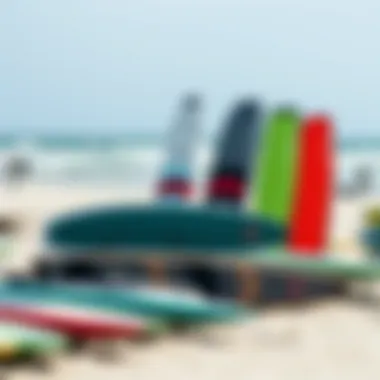

Size and Shape Considerations
When selecting a board, size and shape are essential factors to consider. Larger boards offer more surface area, providing greater stability and making it easier for beginners to stay afloat. Conversely, smaller boards are faster but can require more balance and skill.
A wider board is also beneficial for those just starting, as it allows for easier balance. Ultimately, choosing a board that fits your body weight, height, and skill level is key. The wrong choice can lead to frustration and hinder your learning.
"The right board will feel like an extension of yourself; choose wisely."
Exploring these core components is foundational on your journey into kiteboarding. Taking the time to understand the nuances of kites and boards not only aids in making informed purchases but also contributes to a more enjoyable—and safer—experience on the water.
For further reading on kiteboarding gear, visit Wikipedia and British Kite Sports Association for insights from professionals in the field.
Safety Gear for Beginners
When stepping into the exhilarating world of kiteboarding, safety gear might feel like an afterthought. However, it's one of the keystones for those just starting out. Kiteboarding presents challenges—even under perfect conditions—and wearing the right safety equipment can make all the difference between a glorious day on the water and a traumatic experience.
Safety gear not only protects you but also boosts your confidence. Imagine soaring across the water, and you see an unexpected gust of wind or a wave that catches you off guard. Having the right gear shields you from impacts and minimizes risk, allowing you to focus on mastering your skills without being overly concerned about potential accidents.
Beyond just a comfort blanket, safety gear is tailored to the unique challenges of kiteboarding. It's designed to absorb shocks, protect vital areas, and ensure that each outing is as enjoyable as it is safe. Let’s delve deeper into the specific types of equipment that novices should consider.
Importance of Safety Equipment
The significance of safety equipment in kiteboarding cannot be overstated. With unpredictable wind patterns and the strong pull of a kite, having protective gear is essential for longevity in this sport. For a beginner, this might mean the difference between overcoming falls and injuries or succumbing to the sport's physical demands early on. In essence, safety gear creates a buffer, allowing beginners the grace to learn while mitigating inherent risks.
Consider this: without proper protection, a simple miscalculation could lead to injuries requiring medical attention. The right gear reduces the impact of falls and provides essential buoyancy. It's not just about looking cool; it's about safeguarding your body while you're out in the elements.
Essential Safety Gear
Helmets
Helmets serve as the first line of defense against potential head injuries during kiteboarding. Not just any helmet will do; one that’s specifically designed for water sports is crucial. These helmets are constructed to be lightweight yet sturdy, allowing for safety without weighing you down. A key characteristic of these helmets is their ability to float, meaning that if you take a tumble, it won’t sink beneath the waves.
"Choosing a water sports helmet could save your life. It’s no joke; a sound noggin should be high on your priority list."
The unique feature of a good water sports helmet is its snug fit, preventing it from coming off during unexpected tumbles. While they are beneficial, some helmets may trap heat in hot weather. Hence, ventilation options are something to check. Look for models with good airflow and comfort lining to keep your head cool.
Impact Vests
Next on the list is the impact vest. These vests provide necessary insulation and additional protection against collisions. Think of them as body armor for the water. A central feature of impact vests is their ability to cushion against impacts, particularly when the kite suddenly pulls you into the water or if you're learning to jump.
These vests not only help in protecting vital organs but also provide buoyancy, assisting you if you get caught in a tough spot. One advantage is that many models are designed to be worn comfortably under your wetsuit, making them a seamless part of your gear. However, the downside is that some may feel restrictive to movement, especially during intense maneuvers.
Safety Leashes
Safety leashes are crucial for keeping you connected to your kite. In the event of a wipeout or severe loss of control, these leashes help to prevent the kite from flying away or causing harm to others on the water. The fundamental characteristic of safety leashes is their break-away design, which allows them to detach when too much tension is applied, thus averting potential accidents.
These leashes come with varying lengths and styles. A unique feature worth noting is the quick-release mechanism, allowing you to separate quickly from the kite if needed. They often come with a coiled design, minimizing drag while ensuring that the leash doesn’t float around and interfere with your session. While they’re essential, it’s crucial to inspect them regularly to ensure they have not suffered any wear and tear.
In summary, investing in these key pieces of safety gear creates a solid foundation for your kiteboarding experience. By ensuring you're well-equipped, you can take the plunge into kiteboarding with more confidence, safety in mind, and a spirit of adventure.
Choosing a Harness
When starting out in kiteboarding, the harness is often overlooked but its importance cannot be overstated. It acts as the vital link between you and the kite, transferring the forces from the kite to your body while distributing the load evenly across your torso. A well-chosen harness ensures that you can maintain control and comfort while riding. Beginners should approach this essential piece of equipment with care, as the right harness not only enhances performance but also adds to safety on the water.
Different Types of Harnesses
Waist Harness
The waist harness is a common choice among kiteboarders. It sits around the waist, providing a snug fit that allows for more freedom of movement in comparison to other styles. The key characteristic of a waist harness is its streamlined profile, which helps to keep the kite’s pull centered over the rider’s body. This design reduces the risk of being pulled off balance, which can often happen when learning new maneuvers.
One notable feature of the waist harness is that it offers a greater range of motion for your upper body, making it easier to perform tricks and navigate in tricky conditions. However, it might not provide as much support for those who are heavier or just starting out. Beginners might find it somewhat uncomfortable if they lack experience, but many find it to be a beneficial choice as they progress in their skills.
Seat Harness
On the other hand, the seat harness is designed to offer additional support, sitting lower on the body and typically covering more area. This design can be especially helpful for newcomers who may not yet have the core strength needed to handle a waist harness effectively. The key characteristic here is the extra support it offers, which allows beginners to focus more on learning how to control the kite without getting too fatigued.
A unique feature of the seat harness is its ability to stabilize the body, making it harder to get yanked around by the kite. However, one might find it restricts movement more than a waist harness does. Although less popular among advanced riders, for beginners it can be a vital tool that eases the learning curve.
Hybrid Harness
Lastly, the hybrid harness is a recent development that attempts to blend the attributes of both waist and seat harnesses. This hybrid design allows for versatility and addresses several comfort and stability concerns that beginners may face. The key characteristic here is its adaptable structure, which aims to cater to various riding styles and conditions.
With a hybrid harness, you can enjoy the mobility of a waist harness while still getting extra support similar to that of a seat harness. One downside, however, is that it may not provide the same level of optimal performance as specialized harnesses when used in specific situations. Nonetheless, for novice kiteboarders looking to experiment, a hybrid harness can serve as a great intermediate solution.
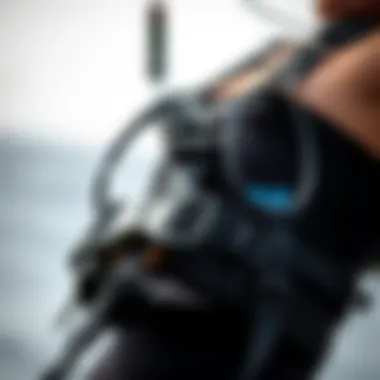

Finding the Correct Fit
Getting the right fit is essential in ensuring comfort and performance when it comes to harnesses. A harness that’s too loose can slip off, while one that’s overly tight can hinder movement and even restrict breathing. When trying on harnesses, pay attention to the way it feels when you are upright and in different positions, such as when practicing your launch or jibe. The goal is to find a balance where the harness is snug enough to stay in place but still allows for some mobility.
Wetsuits and Other Apparel
In kiteboarding, wearing the right gear is crucial, but it's easy to overlook the significance of wetsuits and other attire. When you hit the water, the temperature can change quicker than the wind, and being unprepared can lead to a miserable experience, or worse, safety issues. Protective clothing keeps you warm and allows for better movement, so learning about different types and their features can help you to enjoy your time on the water while making a solid fashion statement.
Wetsuit Types Explained
Full Wetsuits
Full wetsuits are the go-to choice for most kiteboarders when the water’s a bit chilly. These suits cover everything – your arms, legs, and torso, giving you a snug fit that keeps the heat in. A key characteristic of full wetsuits is their thickness, usually measured in millimeters, with thicker options being better for colder conditions.
One reason beginners lean towards full wetsuits is their versatility. They've got built-in insulation, allowing you to stay out longer without the shivers. On the flip side, they can be a bit restrictive in movement compared to shorter options. Still, they’re great for those who plan to ride in varied temperatures.
Shorty Wetsuits
Shorty wetsuits are like a hybrid suit, hitting a sweet spot between comfort and coverage. These suits typically cover the chest and torso but leave the arms and legs bare, making them ideal for warmer weather. Their lighter material allows for more freedom of movement, which is a major plus when you’re learning new tricks.
The key aspect of shorty wetsuits is how they cater to warmer conditions efficiently. Beginners often find shorties appealing because they provide that extra bit of warmth for those early morning sessions without overheating. However, they might not suffice in cooler waters or windy conditions, where a full wetsuit really shines.
Drysuits
Drysuits take it up a notch for serious kiteboarders venturing into colder waters. Unlike wetsuits that rely on a thin layer of water for insulation, drysuits keep you completely dry. Made with materials that are waterproof and breathable, they help maintain a steady body temperature.
One of the benefits of drysuits is their effectiveness in extreme conditions, allowing you to kiteboard with ease even when temperatures plummet. However, they can come with a higher price tag and might require a bit of acclimatization for maximum comfort in terms of movement.
Condition-Appropriate Clothing
Sun Protection
When kiteboarding, you can’t ignore the risks from the sun. Sun protection gear—like rash guards, UV-blocking shirts, and hats—plays an essential role in safeguarding skin from harsh rays. A critical aspect of sun protection is the UPF rating, which tells you how effectively the fabric blocks ultraviolet radiation.
For newcomers, investing in sun-friendly clothing is a smart move. It helps prevent sunburn and long-term skin damage, allowing you to focus on perfecting your skills without that searing sunburn ruining your fun. However, remember that these garments should be lightweight and breathable to maintain comfort on the water.
Wearing Layers
Layering is vital, especially as temperatures can swing like a yo-yo throughout the day. It’s all about thinking smart with your wardrobe. The layering technique lets you adapt quickly: you can start with a base layer that wicks away moisture, then add insulation and a waterproof layer on top.
The key benefit of wearing layers is flexibility. As you ride, if the sun comes out or the wind picks up, having the option to shed or add layers is a lifesaver. Conversely, too many layers can feel cumbersome and restrict movement, so strike a balance that works for your style.
Additional Kiteboarding Accessories
When you first think about kiteboarding, the initial images often revolve around kites and boards. But, there’s more to the story. The accessories that you may not think about at first can greatly enhance your experience and keep you safe while you’re gliding over the water. Understanding these additional kiteboarding accessories not only helps you make better purchases but also ensures that you're well-prepared for a fun and safe time on the water.
Bar and Lines
Bar Types
A kiteboarder's control starts with the bar. It’s an indispensable tool that directly affects your ability to steer and command your kite. Bars come in various types, each tailored to suit different riding styles and preferences. The most common are the standard control bars, which often have adjustable widths, making them somewhat versatile for various kite sizes.
One key characteristic of many bars is the safety system, a feature that allows you to quickly depower the kite in a sticky situation.
- Benefits: A good bar provides not just control but also safety. You want a bar that feels comfortable in your hands and responds well to your movements. A well-designed bar can significantly improve your confidence and performance.
- Disadvantages: On the flip side, the complexity of some bars might overwhelm beginners. Choosing a bar with too many features can sometimes make it difficult to learn the basics effectively.
Line Lengths
When we talk about line lengths, we’re diving into an area that’s crucial for how the kite reacts. Longer lines give you more power and speed but can also make it harder to control. On the other hand, shorter lines allow for quicker turns and easier control, which is often more favorable for beginners.
- Key characteristic: The most common lengths range from 20 to 30 meters, but this largely depends on your kite type and conditions.
- Benefits: Finding the right length can improve your kite's performance. For beginners, shorter lines typically provide easier management, giving you that little extra peace of mind while you're learning.
- Disadvantages: However, shorter lines may limit your ability to enjoy the full power of larger kites, especially in lighter winds.
Pumps and Repairs
Manual vs Electric Pumps
Getting your gear ready for the water often starts with inflation, and that’s where pumps come in. Manual pumps require elbow grease, while electric pumps offer convenience at the press of a button. Both have their merits.
- Key characteristics: Manual pumps are usually more cost-effective and reliable, needing no battery. However, they require physical effort, which can tire you out before you even hit the waves.
- Benefits: On the other hand, electric pumps save time and energy, allowing you to inflate your kite in mere minutes, which is excellent if you’re eager to get started.
- Disadvantages: But, the reliance on electricity can pose an issue in remote locations where outlets are scarce.
Understanding Repairs and Maintenance
Every kiteboarder eventually faces the reality of repairs. Whether it's a small tear in your kite or a snapped line, understanding maintenance can save you both time and money. Regular checks and basic repairs can keep your gear in good shape and prolong its lifespan.


- Key characteristic: Maintaining your gear means investing a little time to inspect your equipment regularly for wear and tear.
- Benefits: Knowing how to perform basic repairs lets you enjoy your time on the water without stressing about costly replacements. You’ll develop a keener eye for spotting potential issues before they escalate.
- Disadvantages: However, repairs can be a bit tricky for beginners without experience, and mishaps may cause further damage if not done properly.
Investing in the right accessories can make the difference between a frustrating day and an exhilarating experience on the water.
Budgeting for First Gear Purchases
When stepping into the world of kiteboarding, one key consideration that can’t be brushed aside is budgeting for your first gear purchases. After all, kiteboarding is a thrilling sport, but it also comes with some hefty expenses. Being aware of your finances can set you on a successful path towards your kiteboarding journey.
In this section, we’ll explore various elements regarding budgeting: how to estimate total costs effectively and what aspects to consider when evaluating the best bang for your buck.
Estimating Total Costs
Estimating total costs accurately gives you a clearer picture of what you’re getting into. Kiteboarding gear can quickly range from a few hundred to several thousand dollars, depending on your choices. Here are a few major components to consider:
- Kite: This alone can vary depending on the type and brand. Expect to spend between $500 to $1,500.
- Board: Typically priced between $300 to $1,200.
- Harness: A worthwhile investment, often costing $100 to $300.
- Wetsuit: Depending on the material and thickness, expect costs ranging from $100 to $500.
- Miscellaneous Gear: Accessories like safety equipment, straps, and lines can add another $100 to $500.
When adding these figures up, you might find the total could easily hit around $1,200, particularly if you include essentials like a good pump and impact vests. What this highlights, is the importance of not just figuring out immediate costs, but also considering future gear upgrades as you improve your skills.
Evaluating Value vs. Price
Price tags can often mislead. Just because an item is a bit pricier doesn't always mean it's the best choice for your needs. Here are factors you should weigh to evaluate value versus price:
- Quality over Quantity: It’s wiser to invest in high-quality items that can withstand wear and tear rather than buying multiple low-cost alternatives.
- Brand Reputation: Certain brands, like Cabrinha or Naish, have built trust over the years. Investing in well-reviewed gear can pay off in the long run, as reliability in gear can be critical for safety and performance.
- Performance: Each piece of gear you select has specific functionalities. For instance, an inflated kite that’s easy to handle can be more beneficial than a cheaper kite that gives you a hard time learning the basics.
- Resale Value: Remember that some brands and items hold their value better than others. If you plan to upgrade, consider the resale potential when making purchases.
Effective budgeting is the key to diving into this thrilling sport without breaking the bank. Understand what you really need versus what might be considered unnecessary frills.
For more dive into the finances of kiteboarding, you might check out resources like Wikipedia and forums on Reddit for conversations among kiteboarders about budgeting strategies.
Where to Buy Kiteboarding Gear
When diving into the world of kiteboarding, one of the crucial decisions is where to acquire your gear. This section explores the dual avenues of purchasing gear, each with its distinct advantages and considerations. Understanding the pros and cons helps you navigate this essential part of your kiteboarding journey.
Local Shops vs Online Retailers
Choosing between local shops and online retailers can feel like a bit of a tug-of-war. Both options come with perks and pitfalls, and your choice could significantly impact your overall experience.
Local shops can be a treasure trove of support. For beginners, the ability to physically handle the equipment is invaluable. You can ask questions, get advice from seasoned staff, and sometimes even try out the gear. The personal connection adds clarity to your decision-making. Plus, supporting local business keeps your community thriving. You might even bump into fellow kiteboarders who share tips and stories.
On the flip side, online shopping often offers lower prices, a wider selection, and the convenience of comparing many products at the click of a button. Websites like Amazon, eBay, and dedicated kiteboarding retailers make it easy to find gear that suits your needs. However, the downside is that you miss out on that all-important feel of the gear. When it comes to items like kites and harnesses, getting the fit right is critical for comfort and performance.
Used vs New Gear
Another key consideration for beginners is whether to go for used gear or new. Both have their advantages, and being aware of them can lead to smarter, more economical decisions.
New Gear:
- Warranty coverage: New equipment typically comes with a warranty, ensuring that you're protected against defects.
- Latest technology: Opting for new gear often means that you’re using the most up-to-date technology. Advances in kite design or board shape can enhance your performance and safety.
- Customization: With new gear, you can select exactly what you want, tailoring everything to your preferences.
However, new gear can be pricey. It’s not uncommon for beginners to feel the sting in their wallet when buying a complete set.
Used Gear:
- Affordability: Buying second-hand gear allows you to save a chunk of change. This is often a great way for beginners to experience kiteboarding without emptying their savings.
- Access to higher-end equipment: You may find deals on gear that you wouldn’t normally splurge on if buying new. Higher-quality gear at a fraction of the cost can sometimes mean better performance.
- Experience: Using second-hand equipment can provide insights into what features you value most, aiding future purchases.
Of course, buying used gear isn't without its hazards. You should scrutinize any used equipment carefully. Look for signs of wear and tear, especially on kites and lines. The last thing you want is equipment that could fail while you're out on the water.
"Whether you choose local shops or online marketplaces, make informed decisions by doing thorough research and always trying on before you buy."
Culmination: Making Informed Decisions
As you venture into the exciting world of kiteboarding, the choices you make in selecting your gear can greatly impact your experience on the water. This article has covered the crucial aspects of kiteboarding gear, yet it is important to underline the necessity of making informed decisions. Recognizing the complexities of different equipment types—be it kites, boards, harnesses, or safety gear—enables you to choose wisely right from the get-go. The right choice not only enhances your performance but also significantly contributes to your safety and enjoyment.
Prioritizing Safety and Quality
In kiteboarding, safety isn't just an afterthought; it’s paramount. Think of safety gear as your lifeline on the water. Investing in high-quality safety equipment is like putting on your seatbelt before a drive. It’s vital that your helmet, impact vest, and safety leash meet industry standards. A poor-quality helmet could mean the difference between a minor bump and a serious head injury.
When buying gear, scrutinize the materials used and consider the reputation of the brand. Reading reviews and getting recommendations from experienced kiteboarders can guide you toward safer choices. For instance, products by brands like Naish or Cabrinha are often highlighted for their reliability and durability.
Choosing a harness that’s both functional and comfortable is equally important. You’ll likely find yourself spending hours in it, and a poorly fitting harness can lead to discomfort or even injuries. So, prioritize quality over price whenever possible. An investment in safety might seem steep at first but remember, a safe ride allows you to focus on improving your skills and having fun.
"An ounce of prevention is worth a pound of cure."
Embracing the Learning Journey
Every kiteboarder starts as a beginner, facing different challenges along the way. It’s crucial to embrace this journey of learning; after all, every expert was once an amateur. Understanding your equipment and how to use it effectively is part and parcel of the kiteboarding experience. Take the time to learn about wind conditions, techniques, and equipment maintenance. These facets are just as vital as the gear you choose.
Moreover, don't shy away from seeking help. Participating in lessons or joining a kiteboarding community can provide you with valuable insights, tips, and tricks. Engaging with more experienced boarders can lead to shared knowledge that will smooth your path to proficiency. Your decisions today set the foundation for tomorrow's adventures. Focus not only on gear but also on personal growth, and the rewards will be worth it.
As you reflect on your learning journey, remember to evaluate everything. Think about what works for you and what doesn't. Kiteboarding is an evolving sport, and being adaptable is key. With persistence and an informed approach, you can navigate the waters confidently. After all, kiteboarding is not just about the gear; it’s also about enjoying and managing the serene chaos of nature.






